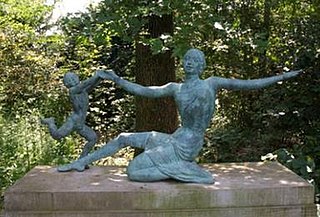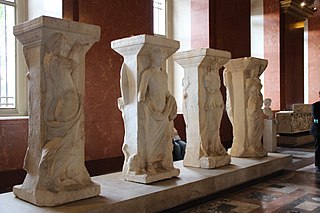
In Greek mythology, Silenus was a companion and tutor to the wine god Dionysus. He is typically older than the satyrs of the Dionysian retinue (thiasos), and sometimes considerably older, in which case he may be referred to as a Papposilenus. Silen and its plural sileni refer to the mythological figure as a type that is sometimes thought to be differentiated from a satyr by having the attributes of a horse rather than a goat, though usage of the two words is not consistent enough to permit a sharp distinction.

In Greek mythology, maenads were the female followers of Dionysus and the most significant members of the thiasus, the god's retinue. Their name, which comes from μαίνομαι, literally translates as 'raving ones'. Maenads were known as Bassarids, Bacchae, or Bacchantes in Roman mythology after the penchant of the equivalent Roman god, Bacchus, to wear a bassaris or fox skin.

Bacchus (1496–1497) is a marble sculpture by the Italian High Renaissance sculptor, painter, architect and poet Michelangelo. The statue is somewhat over life-size and represents Bacchus, the Roman god of wine, in a reeling pose suggestive of drunkenness. Commissioned by Raffaele Riario, a high-ranking Cardinal and collector of antique sculpture, it was rejected by him and was bought instead by Jacopo Galli, Riario's banker and a friend to Michelangelo. Together with the Pietà, the Bacchus is one of only two surviving sculptures from the artist's first period in Rome.

The Borghese Vase is a monumental bell-shaped krater sculpted in Athens from Pentelic marble in the second half of the 1st century BC as a garden ornament for the Roman market; it is now in the Louvre Museum.

The House of the Vettii is a domus located in the Roman town Pompeii, which was preserved by the eruption of Mount Vesuvius in 79 AD. The house is named for its owners, two successful freedmen: Aulus Vettius Conviva, an Augustalis, and Aulus Vettius Restitutus. Its careful excavation has preserved almost all of the wall frescos, which were completed following the earthquake of 62 AD, in the manner art historians term the Pompeiian Fourth Style. The House of Vetti is located in region VI, near the Vesuvian Gate, bordered by the Vicolo di Mercurio and the Vicolo dei Vettii. The house is one of the largest domus in Pompeii, spanning the entire southern section of block 15. The plan is fashioned in a typical Roman domus with the exception of a tablinum, which is not included. There are twelve mythological scenes across four cubiculum and one triclinium. The house was reopened to tourists in January 2023 after two decades of restoration.

The Dionysus Sardanapalus is an uncommon Hellenistic-Roman Neo Attic sculpture-type of the god Dionysus, misnamed after the king Sardanapalus. Unlike most contemporary figurations of Dionysus as a lithe youth, the self-consciously archaising god is heavily draped, with an ivy wreath and a long archaic-style beard; probably he bore a thyrsos in a raised right hand, now missing.

The Resting Satyr or Leaning Satyr, also known as the Satyr anapauomenos is a statue type generally attributed to the ancient Greek sculptor Praxiteles. Some 115 examples of the type are known, of which the best known is in the Capitoline Museums.

The Values of Civilization sculpture group is public art by American artist Alexander Doyle. The allegorical sculpture group is located on the third floor in the rotunda of the Indiana State House, which is in Indianapolis, Indiana, United States. The heroic-sized sculptures, representing Agriculture, Art, Commerce, History, Justice, Law, Liberty, and Oratory, were carved from Carrara marble in Italy in the late 1880s.

Sundial, Boy With Spider is an outdoor sculpture and functional sundial by American artist Willard Dryden Paddock (1873–1956). It is located within the Oldfields estate on the grounds of the Indianapolis Museum of Art (IMA), in Indianapolis, Indiana, United States. The bronze sculpture, cast by the Gorham Manufacturing Company, depicts a boy sitting cross-legged with an open scroll in his lap.

Nymph and Fawn is a public artwork by American artist Isidore Konti and located within the Oldfields–Lilly House & Gardens estate on the grounds of the Indianapolis Museum of Art (IMA), near Indianapolis, Indiana. Created in 1917, the bronze sculpture is also a working fountain. It portrays a female nude pouring water from an urn while standing beside a small fawn.

Mother and Child is a public artwork by the Estonian-British artist Dora Gordine, located at the Indianapolis Museum of Art (IMA), which is near downtown Indianapolis, Indiana. The cast bronze artwork was created in 1964 and portrays a woman kneeling beside a small child, both figures displaying joyful poses and expressions.

The Three Graces is a nearly life-size, figurative Carrara marble outdoor sculpture group located on the historic Oldfields estate on the campus of the Indianapolis Museum of Art (IMA), in Indianapolis, Indiana. The neoclassical marble sculpture depicts the Three Graces, minor goddesses of the Greco-Roman pantheon. The group consists of three women frontally oriented, standing in a row upon a base. The sculpture is modeled after a c. 1797 sculpture by Antonio Canova.

Birdbath, constructed of fieldstone and concrete, is an early 20th-century decorative feature on the historic Oldfields estate on the campus of the Indianapolis Museum of Art (IMA), in Indianapolis, Indiana. It is now an accessioned work of art in the collection of the IMA.
The Four Seasons are a set of four stone allegorical putti, each representing a traditional, temperate season. These are a part of the outdoor sculpture collection of the historic Oldfields estate, located on the campus of the Indianapolis Museum of Art (IMA), in Indianapolis, Indiana.

The Old Drunkard is a female seated statue from the Hellenistic period, which survives in two Roman marble copies. The original was probably also made of marble. This genre sculpture is notable for its stark realism.

Python was a Greek vase painter in the city of Poseidonia in Campania, Southern Italy, one of the major cities of Magna Graecia in the fourth Century BC. Together with his close collaborator and likely master Asteas, Python is one of only two vase painters from Southern Italy whose names have survived on extant works. It has even been suggested that the joint workshop of Asteas and Python in Paestum was a family business.

The Athenian Band Cup is an Attic Greek kylix attributed to the Oakeshott Painter. It is further classified as a band cup, a type of Little-Master cup.

The Triumph of Bacchus is a painting by the Walloon artist Michaelina Wautier. It was painted between 1650 and 1656 and is one of Wautier's greatest works, as well as her largest. Based on classical texts, the picture shows a procession with the drunken god Bacchus at its centre, surrounded by other humans, satyrs, and animals. It is notable for its large number of nude male figures, something uncommon from a woman artist in this period.

The Bema of Phaidros is the marble platform created in the third century CE that served as stage front to the Theatre of Dionysos in Athens. It is decorated with a Neo-Attic Roman sculpture of the Hadrianic or Antonine period, this sculpture was dismantled sometime in antiquity, moved from an unknown location, and rebuilt into the bema of the Theatre by Phaidros, archon of Athens. Four stone reliefs decorate the stage front illustrating scenes from the life of Dionysos they are: 1) The birth of Dionysos, 2) the entrance of Dionysos into Attica, 3) the sacred marriage of Dionysos and the Basilinna and 4) the enthronement of Dionysos. These scenes are framed by crouching Silenoi.

Las Incantadas of Salonica is a group of Roman sculptures from a portico dating to the second century AD that once adorned the Roman Forum of Thessalonica in Northern Greece, and were considered to be among the most impressive and prestigious monuments of the city. Based on descriptions by travellers, it consisted of five Corinthian columns with four of them having bilateral sculptures on each pillar above. The sculptures were removed in 1864 by French paleologist Emmanuel Miller and placed in the Louvre museum in France, while the rest of the building collapsed and was destroyed. A fragment from a lost, fifth pillar was discovered in the city in the late twentieth century.




















